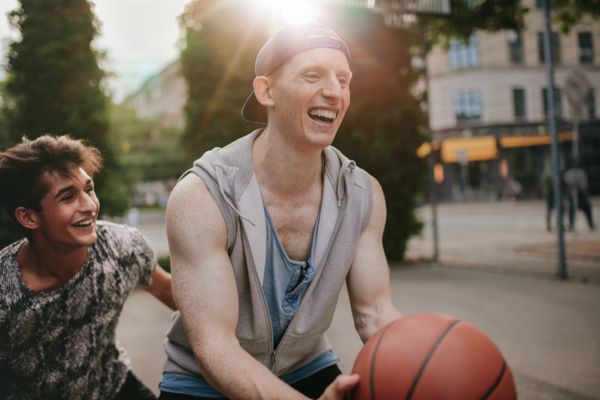5 common summer injuries you should know about
Author Details
Reg. PT., M.Sc.PT., H.B.K. | National Director of Program Development, Specialty Services

Summer is upon us, which for most means spending more time outside under the sun. As much as we love outdoor activities, they pose some risk of injury due to factors like footwear, body mechanics, and the outdoor environment itself.
The good news is that appropriate early care of injuries can optimize the recovery process and get you back to doing what you love with confidence. This article will review five commonly seen injuries during the summertime, as well as the recommended approach to caring for them.
1. Plantar fasciitis
Plantar fasciitis (PF) is a condition that occurs with repetitive overload of your foot arch, common in activities like running or hiking. Factors that increase the risk of PF include having a “flat-foot” arch or wearing unsupportive footwear, such as flip-flops. PF may present with the following:
- Pain on the bottom of the foot near the heel or foot arch
- Pain with the first few steps in the morning
- Increased pain when standing after prolonged sitting
- Pain after exercising
- Swelling at the heel
- Tightness of the Achilles tendon
2. Shin splints
Shin splints is the inflammation of muscles and tendons around your shin bone, caused by repetitive loading and body mechanics. It may vary in severity - from pain after stopping exercising to continuous pain with every step. Shin splints can contribute to stress fractures in severe cases. With shin splints, soreness is felt along the inner side of your shinbone and lower leg.
3. Ankle sprain
An ankle sprain is when the ligaments that support the ankle are overstretched from a stressful force. We often see ankle sprains in the summer due to activities that require forceful movements like jumping, twisting, and walking on uneven surfaces.
4. Tennis elbow
Tennis elbow is when the tendons attaching to the outside of the elbow are overloaded. This most often occurs from repetitive movements of the forearm muscles. Despite what the name suggests, many other arm-focused activities can put you at risk of developing tennis elbow, including squash, fencing, baseball, and rock climbing among many others.
5. Back strain
Injuries to the tendons and muscles of the back are common in sports that require repetitive impact (e.g., running), twisting (e.g., golf), or weight loading (e.g., football, weightlifting, garden work). A back strain may cause symptoms like:
- Pain in the area between the shoulder blades
- Back muscle spasms
- Knots or feelings of tightness
- Pain that worsens with movement, or persists with sitting, standing, or walking
- Limited ability to move
- Pain radiating into the hips or legs
PEACE & LOVE your injury
The acronym PEACE & LOVE was created to guide injury management and takes into consideration the optimal healing environment for your body. Immediately after an injury to a muscle or ligament, you’ll want to use PEACE:
- Protect
- Offload the injury site and restrict movement for the first 1-3 days to reduce bleeding and prevent further aggravation.
- Offload the injury site and restrict movement for the first 1-3 days to reduce bleeding and prevent further aggravation.
- Elevate
- Elevate the area higher than the heart to promote fluid drainage from the injury site.
- Elevate the area higher than the heart to promote fluid drainage from the injury site.
- Avoid anti-inflammatory modalities
- Allow the inflammatory process to occur, as it is necessary for optimal healing.
- Avoid the overuse of medications and ice unless needed for pain relief.
- Compress
- Mechanical compression such as taping or bandages can help control excessive swelling.
- Mechanical compression such as taping or bandages can help control excessive swelling.
- Educate
- A healthcare professional can educate you on best practices for injury management.
After the first few days, the inflammatory process will begin to subside and it is time to start treating your injury with LOVE:
- Load
- As soon as symptoms allow for it, you’ll want to start loading the injured muscle or ligament with activity and movement to promote healing.
- As soon as symptoms allow for it, you’ll want to start loading the injured muscle or ligament with activity and movement to promote healing.
- Optimism
- Your psychological state can impact the recovery process.
- It’s helpful to set realistic goals and expectations, work with a physiotherapist, and participate in activities that are meaningful to you.
- Vascularization
- Activities that get your heart pumping also optimize recovery, improve function, and reduce the need for pain medications.
- Activities that get your heart pumping also optimize recovery, improve function, and reduce the need for pain medications.
- Exercise
- Exercise has a wide range of benefits, including restoring movement, balance, and strength of your joints after an injury.
Learn more about PEACE & LOVE principle.
With these common injuries, the body will respond with its natural healing processes. However, there are steps you can take to provide an optimal healing environment for your body’s tissues, which can lead to better recovery.
A physiotherapist can help you implement the PEACE & LOVE principles into your recovery journey and get you back to your favourite outdoor activities as soon and safely as possible.
For more information on how Lifemark clinicians can help you prevent injuries this summer, check out our locations page to find a clinic near you or book online.
This blog was written by Yuzana Wynn, a University of of Toronto physiotherapy student.
Author Details
Reg. PT., M.Sc.PT., H.B.K. | National Director of Program Development, Specialty Services
We can help you move and feel better.
Book an appointment today.